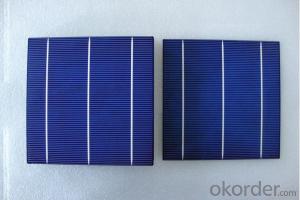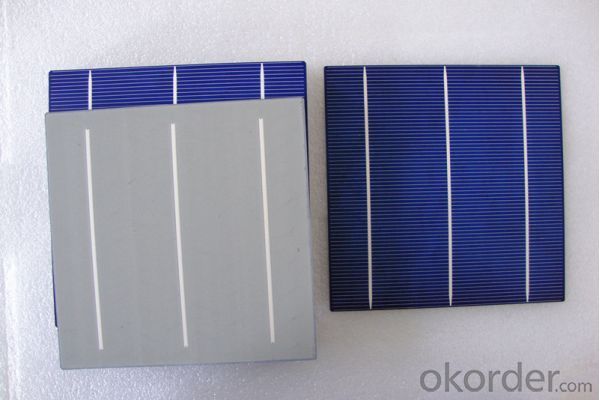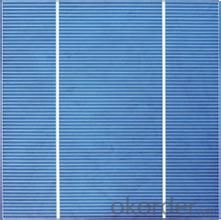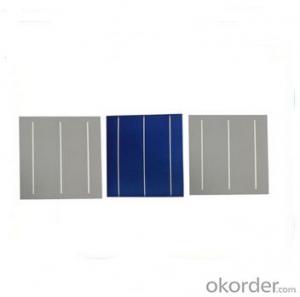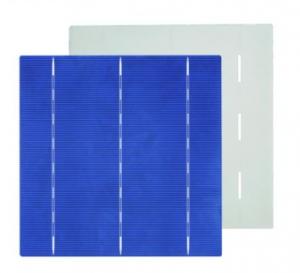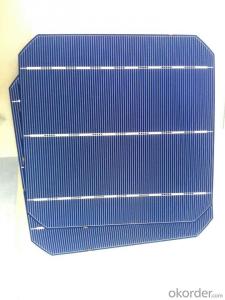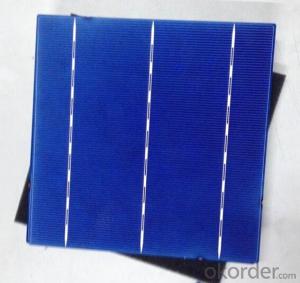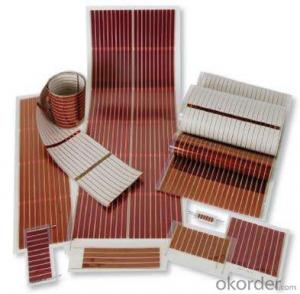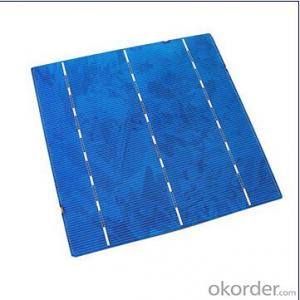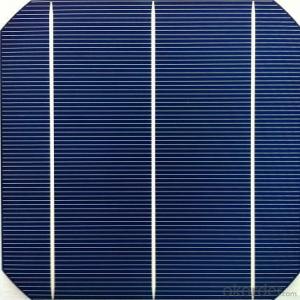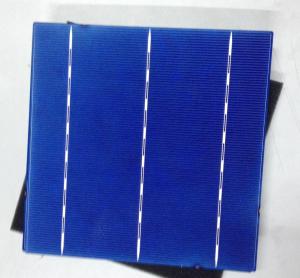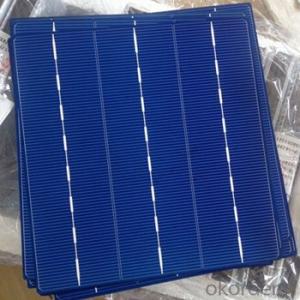12 Volt Solar Cells - Lower Price but Constant Good Quality Polycrystalline 156 Solar Cell High Efficiency
- Loading Port:
- Shanghai
- Payment Terms:
- TT or LC
- Min Order Qty:
- 1000 pc
- Supply Capability:
- 20000 pc/month
OKorder Service Pledge
OKorder Financial Service
You Might Also Like
| Packaging & Delivery | |
| Packaging Detail: | solar cell, 10boxes*100pcs in one carton, safe enough for transfer |
| Delivery Detail: | 5~7 days after receive deposit |
| Specifications | |
| solar cell for solar panel | |
| 1.16.8%~18.25% high efficiency | |
| 2.100% checked quality | |
| 3.ISO9001/ISO14001/TUV/UL | |
| 4.fast lead time | |
Product Description
POLY6'(156*156) Multicrystalline Silicon solar celle
Diagonal: 220mm±0.5mm
Thickness(Si): 200±20 μm
Dimension: 156mm×156mm±0.5mm
Front(-) Back(+)
Blue anti-reflecting coating (silicon nitride); Aluminum back surface field;
1.5mm wide bus bars; 2.0mm wide soldering pads;
Distance between bus bars: 51mm. Distance between bus bars :51mm.
| poly 156 cell Electrical Characteristics( solar cell for solar panel ) | ||||||||||||
| Efficiency(%) | 18 | 17.8 | 17.6 | 17.4 | 17.2 | 16.8 | 16.6 | 16.4 | 16.2 | 16 | 15.8 | 15.6 |
| Pmpp(W) | 4.33 | 4.29 | 4.24 | 4.19 | 4.14 | 4.09 | 4.04 | 3.99 | 3.94 | 3.9 | 3.86 | 3.82 |
| Umpp(V) | 0.53 | 0.527 | 0.524 | 0.521 | 0.518 | 0.516 | 0.514 | 0.511 | 0.509 | 0.506 | 0.503 | 0.501 |
| Impp(A) | 8.159 | 8.126 | 8.081 | 8.035 | 7.99 | 7.938 | 7.876 | 7.813 | 7.754 | 7.698 | 7.642 | 7.586 |
| Uoc(V) | 0.633 | 0.631 | 0.628 | 0.625 | 0.623 | 0.62 | 0.618 | 0.617 | 0.615 | 0.613 | 0.611 | 0.609 |
| Isc(A) | 8.709 | 8.677 | 8.629 | 8.578 | 8.531 | 8.478 | 8.419 | 8.356 | 8.289 | 8.22 | 8.151 | 8.083 |
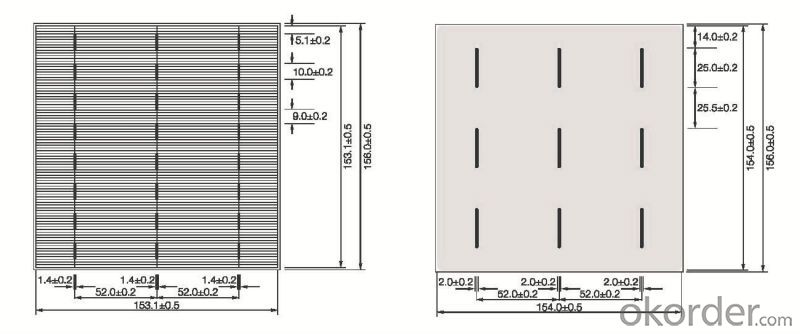
. Warranty:
(1)5years quality assurance resulted from design, material and workmanship;
(2)Not less than 90% power output within 10years;
(3)Not less than 80%power output within 25years;
(4)Third-party insurance(Certificate Of Products Quality Warranty and Certificate Of Products Liability Insurance).
Advantages:
Lower price but constant good quality:
1. Excellent A grade solar cell from JA solar or our own lab;
2. Excellent backsheet from SFC, 3M;
3. EVA from Bridgestone;
4. Junction box with UL and TUV listed, IP65;
5. High transmission low iron tempered glass;
6. Solar panels with TUV, IEC, CE, ISO9001, ISO14001, CEC marked and ETL, MCS in processing;
PACKAGE AND SHIPPING ;
Material in stock can be produce (procedure 5-20days) right away after pre-payment confirmation. COSCO Mearsk MSC or othe ship to worldwide for safe shipping, don't worry about package damager or loss. It take 15-40 days to worldwide, Please note us your contact details include your phone number for easy contacting from shipping company officer.And we have about 12 years in solar panel production and exporting all over th world
Working Principle of Home Solar Cell
Home solar cell is the core part of the solar power system. The role of home solar cell is to convert the sun's light energy into electrical energy, and the DC output is stored in the battery. Home solar cell is the most important part of the solar system, the conversion rate and service life is an important factor in the decision whether to use the solar value.
Brief introduction of Home Solar Cell
1. Cell: High efficiency (over 16.5%) of monocrystalline silicon solar chip package, to ensure adequate power generation solar panels.
2. Glass: low Steel of suede glass (also called white glass), a thickness of 3.2mm, in the wavelength range of the spectral response of the solar cell (320-1100nm) light transmission rate of more than 91%, greater than 1200nm for IR light have a higher reflectivity. This glass also resistant to ultraviolet radiation from the sun, the light transmittance is not decreased.
3. EVA: using plus UV agents, antioxidants and the thickness of the curing agent is 0.78mm high EVA film as a sealant between the solar cell and a glass, TPT linking agent. It has a high light transmittance and resistance to aging.
4. TPT: solar cells on the back cover - fluorine plastic film is white, from the reflection of the sun, so the slight increase in the efficiency of the components, and because of having a high infrared emissivity, can reduce the operating temperature of the component, but also help to improve the efficiency of the module. Of course, this fluorine plastic film solar cell having a first packaging material required aging resistance, corrosion resistance, and the basic requirements, airtight and so on.
5. Border: used in high strength aluminum alloy frame, strong resistance to mechanical shock resistance. Solar Power is the highest value part. Its role is to the sun's radiation is converted to electrical energy stored in batteries or sent to, or promote the work load.
- Q: Can solar cells be used for electric vehicle charging?
- Yes, solar cells can be used for electric vehicle charging. Solar panels can convert sunlight into electricity, which can then be used to charge electric vehicles. This process, known as solar charging, provides a sustainable and renewable energy source for EVs, reducing their dependence on the grid and decreasing carbon emissions.
- Q: How to make solar cells in a scientific way?
- You can make it but you won't get too much energy out of that.
- Q: Where and how can we find the best solar cells suppliers?
- I used to be a solar cells business dealer in the European market for over ten years, and I did not only use the internet to find the supplier, but also go to a lot solar cells industrial exhibition fairs.
- Q: Can solar cells be used in remote sensing applications?
- Yes, solar cells can be used in remote sensing applications. Solar cells can convert sunlight into electrical energy, which can power remote sensing devices and instruments. This allows for continuous and sustainable operation of remote sensing systems in areas where access to traditional power sources may be limited or unavailable. Additionally, solar cells can be integrated into small and lightweight devices, making them ideal for remote sensing applications where portability and efficiency are crucial.
- Q: How are solar cells manufactured?
- Solar cells are manufactured through a multi-step process that involves the production of silicon wafers, the creation of a p-n junction, the addition of anti-reflective coatings, and the assembly of electrical contacts.
- Q: How do solar cells perform in cloudy weather?
- Solar cells can still generate electricity in cloudy weather, although their efficiency is reduced compared to sunny conditions. Cloud cover limits the amount of sunlight reaching the solar panels, resulting in a lower energy output. However, modern solar cell technologies are designed to capture diffused sunlight and can still produce a significant amount of electricity even in cloudy weather.
- Q: Can solar cells be used for powering remote surveillance cameras?
- Yes, solar cells can be used to power remote surveillance cameras. Solar cells convert sunlight into electricity, making them a reliable and sustainable energy source for remote locations where power supply may be limited or unavailable. By harnessing solar energy, surveillance cameras can operate continuously without the need for frequent battery replacements or connection to electrical grids.
- Q: Can solar cells be used for powering remote sensing devices?
- Yes, solar cells can be used to power remote sensing devices. Solar cells convert sunlight into electricity, which can then be used to power various electronic devices, including remote sensing devices. This renewable energy source is particularly advantageous for remote sensing applications as it eliminates the need for traditional power sources and allows for greater flexibility and portability in remote locations.
- Q: Can solar cells be used in telecommunications?
- Yes, solar cells can be used in telecommunications. They can provide a reliable and sustainable source of power for telecommunication equipment, especially in remote or off-grid areas where access to electricity may be limited. Solar cells can be utilized to charge batteries or directly power telecommunication systems, ensuring continuous operation and reducing reliance on traditional energy sources.
- Q: Can solar cells be used for powering satellites?
- Yes, solar cells can be used for powering satellites. Solar cells are often used as the primary power source in satellites due to their ability to convert sunlight into electricity. The solar cells are typically mounted on the satellite's surface to capture sunlight and generate power for various systems and instruments onboard.
Send your message to us
12 Volt Solar Cells - Lower Price but Constant Good Quality Polycrystalline 156 Solar Cell High Efficiency
- Loading Port:
- Shanghai
- Payment Terms:
- TT or LC
- Min Order Qty:
- 1000 pc
- Supply Capability:
- 20000 pc/month
OKorder Service Pledge
OKorder Financial Service
Similar products
Hot products
Hot Searches
Related keywords
